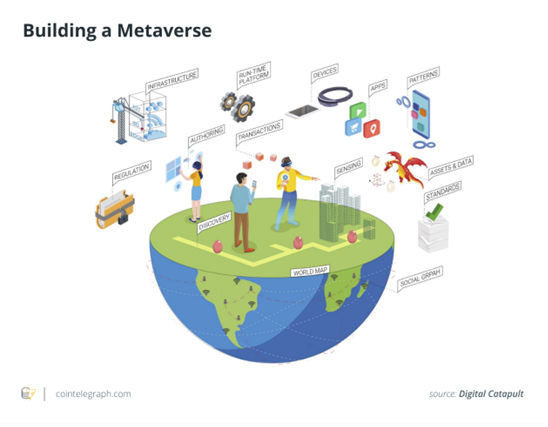“21st Century doesn’t belong to China, US or Silicon Valley. It belongs to the Internet,” – Vytautas, Co-founder at SUPER HOW?.
In this presentation, you’ll find Vytautas Kašėtas’ from SUPER HOW? insights on a metaverse topic which were given during a meet-up with Xplicity.
What is Metaverse?
The metaverse is described as the inevitable evolution of the internet. But what exactly is the metaverse, and what will it become?
In other words, the metaverse is a digital reality that combines aspects of social media, online gaming, augmented reality (AR), virtual reality (VR), and cryptocurrencies that allows users to interact virtually. Augmented reality overlays visual elements, sound, and other sensory input into real-world settings to enhance the user experience. In contrast, virtual reality is entirely virtual and enhances fictional realities.
“It is predicted that a 25% of consumers will use the Metaverse daily by 2026 to work, shop, attend school, socialize or consume entertainment,” says Vytautas.
The size
So, how big is Metaverse? Vytautas suggested that “the best way to measure it is by using money value. Various experts are calculating that metaverse value will reach over $1 T in the next few years. While Blockchain added value is predicted to be $3.1 T by 2030.”
So, according to speaker, there’s no doubt that “21st Century doesn’t belong to China, US or Silicon Valley. It belongs to the Internet.”
Internet as a country
Internet becomes as powerful as a country, and we should take a glance into some milestones. This powerful shift started around 2008-2009 when was documented the first practical use of bitcoin. At that time happening banking crisis was so-what catalysator to the “21st Century Internet” (as we know it now) creation.
Many things happened during that moment, from Pizza day to WAGMI, DeFI, NFTs, etc. The latter – NFTs or non-fungible tokens, are digital assets based on blockchain technology. Anything can become an NFT: a piece of art, sports memorabilia, or even a tweet. Now, as society, we are going into the next period consisting of GameFi and MetaFi.
“The gamification process started as a way to involve communities into this new world. So NFTs built the way, into the next level social networks where virtual world with finances is gamified. It lead to Meta Finances, MetaFI, GameFi, Gaming for Finances concepts. These concepts are based on thinking ‘play and earn’. It means that you can choose if you want to do both or only play/earn”, – explains Vytautas.
As we can see, the beginning of Metaverse as physical, real place (a place where you can go and meet friends) on a given day already exists.
History of Metaverse: Paradigm Shift
If we wanted to better understand how the path to the metaverse was built, it’s important to go through the key elements that had a major impact.
- Science fiction author Neal Stephenson coined the term metaverse in his 1992 novel Snow Crash. In the book, human avatars and software agents interact in a three-dimensional virtual space.
- By 2003 millions of people already worked, played and socialized in the Metaverse within the online Second Life world. Second Life is an online multimedia platform that allows people to create an avatar for themselves and then interact with other users and user created content within a multi-player online virtual world.
- From 2015 Decentraland is the most well-known modern-day “proto Metaverse”. Decentraland is a 3D virtual world browser-based platform. Users may buy virtual plots of land in the platform as NFTs via the MANA cryptocurrency, which uses the Ethereum blockchain. It was opened to the public in 2020.
- From 2018 other interesting projects such as The Sandbox, Axie Infinity appeared. The latter is a non-fungible token-based online video game developed by Vietnamese studio Sky Mavis, known for its in-game economy which uses Ethereum-based cryptocurrencies.

Photo: Decentraland
So Open Metaverse Worlds is a new paradigm interconnected by the digital crypto economy.
The New Paradigm
Metaverse is fundamentally different from contemporary internet/mobile paradigms, design and priorities. 7 Core Metaverse attributes, according to Vytautas:
- Synchronous and live: the Metaverse will be living experience that exists continuously for everyone and in real-time, just as it does in real life. As well, it is 100% continuous – never resets, pauses or ends as it just keeps going endlessly.
- Available individually and concurrently as everyone can be a part of the Metaverse and take part in a specific event/place/ activity simultaneously with their agency in the Metaverse.
- A fully functioning economy. Individuals and businesses should be able to create their own, invest in, sell, and be compensated for a vast array of efforts that produce value.
- An Immersive experience. Engagement is important and Metaverse must be immersive, e.g. it can be done with VR: I put my glasses on and play games, I’m here in Metaverse. Of course, it is important to remember that social immersive experience is a very important attribute as well.
- Mass Collaboration of contributors. Metaverse is built by us to us, every participant becomes a creator.
- Unprecedented Interoperability. Interoperability is another important element as if we want to create a Meta world among all protocols – the interoperability has to exist (it means that interaction is “a must”).
- Metaverse must have decentralized infrastructure.

“There are few elements that are worth to remember when thinking, talking or discussing about Metaverse, as well. First, it is an open world that allows users to own a piece of it, so that all can benefit from the shared network effect that occurs. Second, the ability to own an asset serves as the foundation for a platform that is far greater than the sum of its parts, Last – true digital ownership (virtual property rights) is the foundational block underpinning the entire open metaverse,” – summarizes Vytautas.
The full presentation can be found here: Metavisata_by Vytautas_Kaseta.

